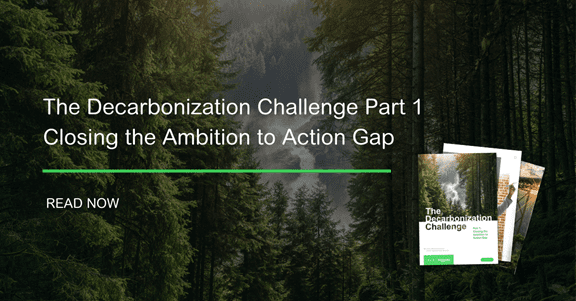 Over the past decade, sustainability has gone mainstream in the global business community. In its 2020 Survey of Sustainability Reporting, KPMG found that 80% of companies worldwide now report on sustainability. Alongside this macro-level trend, climate action and the low-carbon energy transition are gaining traction among governments, investors, boards, and corporate leaders. Institutional investors ranging from BlackRock to Blackstone are beginning to mandate sustainability as a method of managing climate risk. And in Schneider Electric’s 2021 survey of CEOs and energy and sustainability professionals, nearly 75% of respondents said that their business had a climate action plan in place or in development to address climate risk.
Over the past decade, sustainability has gone mainstream in the global business community. In its 2020 Survey of Sustainability Reporting, KPMG found that 80% of companies worldwide now report on sustainability. Alongside this macro-level trend, climate action and the low-carbon energy transition are gaining traction among governments, investors, boards, and corporate leaders. Institutional investors ranging from BlackRock to Blackstone are beginning to mandate sustainability as a method of managing climate risk. And in Schneider Electric’s 2021 survey of CEOs and energy and sustainability professionals, nearly 75% of respondents said that their business had a climate action plan in place or in development to address climate risk.
Study after study points to the significant increase in global GDP that could be harnessed from a transition to an all-electric, all-renewable energy system, to a circular economic model, and to the massive deployment of smart and digital technologies. On an individual company level, there are also numerous risks of not acting or delaying action on climate change.
However, when the threats and opportunities are understood, companies can use climate action as an invitation to respond to crisis while baking resilience into business. Let’s explore how.
Threat: Physical risk
 What has become apparent in the past few years is that the impact of climate change isn’t something happening in the future: it’s happening now.
What has become apparent in the past few years is that the impact of climate change isn’t something happening in the future: it’s happening now.
Hurricanes, nuisance flooding, extreme temperatures, drought, and wildfires are among the causes beginning to have material, physical impacts on business. In 2019, CDP reported that the 200 largest companies in the world together estimated that climate change would collectively cost their businesses more than $1 trillion, with most of the impact coming before 2025.
Climate change is also forecast to disrupt supply chains, leading to increased consumer costs. In March 2021, procurement and supply chain strategist GEP released a report where C-level executives of European and U.S. global companies indicated that supply chain disruption from COVID-19 caused a loss of up to $4 trillion in revenue. This serves as an example of just a slice of the revenue at stake from climate change supply chain disruption.
Learn how our supply chain decarbonization program at Schneider helps companies realize significant environmental impact and improve reliability.
Threat: Transition risk
Companies that don’t adapt ultimately won’t survive. Climate change is the great equalizer when it comes to a business’s license to operate. Companies that don’t respond now by working to mitigate climate risk to protect the long-term viability of their operations, and those that ignore the potential consequences of climate change (ranging from disruption to human health and justice), will eventually fail.
Ambition isn’t enough. Companies must make real progress on their goals and communicate transparently and authentically about that progress. New market expectations on performance and disclosure, as well as legislation in various countries coming down the pipeline to foster climate action, will only continue to heighten operational pressures and mandate a proactive response.
Watch our recent webinar to learn how mapping climate risks and embedding resilience into your strategy can help your company achieve organizational objectives and new growth
Opportunity: Stakeholder pressure
Stakeholder—and specifically investor—pressure has become a top reason why companies today are accelerating their climate ambitions. In his 2021 letter, BlackRock’s CEO Larry Fink wielded the company’s status as the largest asset manager in the world to proclaim that companies that embrace ESG will attract investors and drive better returns—an action that has come to be known in our industry as “the BlackRock effect.”
The scrutiny from shareholders, owners, employees, and customers is fierce, and competition is constantly raising the stakes. While at first glance, this may seem like a risk, the opportunity to align climate action ambitions with the investment community can uncover a wealth of opportunities. In fact, ESG investment has increased 96% in the past year and ESG funds are outperforming the competition.
Opportunity: Market Advantages
While climate action may seem burdensome, in truth, it creates a number of distinct advantages for organizations. These include, and aren’t limited to:
- Less carbon = less cost. Whether through resource reduction, conservation, innovation, or the implementation of more affordable technologies, companies generally save money when they save carbon.
- Sustainable finance = stronger capital management. The acceleration in ESG investing, and the growth in innovative funding methods (like Energy as a Service) means that sustainability can enhance how a business manages its capital and plans for disruption.
- Sustainable reputation = more sales and a better brand. Whether catering to investors, owners, or consumers, a company’s responsible reputation translates into a better brand. This clout can translate into talent attraction, partnerships, value chain engagement, and market influence.
To reap the market advantages of your company’s climate action initiatives, acting alone is no longer enough. The competitive corporate sustainability landscape now demands that companies not only take meaningful, material action on climate change but also communicate and disclose on those actions transparently.
Listen to Schneider sustainability communications experts and MSCI deep dive into how to leverage your company’s sustainability and climate action efforts for effective communication.
Whatever the reason a company begins down the decarbonization journey – whether its moral imperative, investor or consumer pressure, or desire to build resilience or save money – the opportunities and the threats are the same. Private sector engagement is needed for the world to achieve the coordinated effort required to avoid the worst impact of climate change. And the expectation on companies to transform for a low-carbon future is not going anywhere.
We invite you to download part 1 of our Decarbonization Challenge white paper series, Closing the Ambition to Action Gap, where we break down the decarbonization journey and offer pragmatic guidance your company can use to get on the right track.





